市场资讯及洞察

S&P 500 and ASX Rally as Big Banks Drive Markets
Both the S&P 500 and ASX have rallied on the back of stronger-than-expected major bank earnings reports on both sides of the Pacific.
In the US, Bank of America reported a 31% year-over-year increase in earnings per share at $1.06, exceeding Wall Street's estimate of $0.95. Meanwhile, Morgan Stanley delivered a record-breaking quarter with EPS of $2.80, a nearly 49% increase from the same period last year.
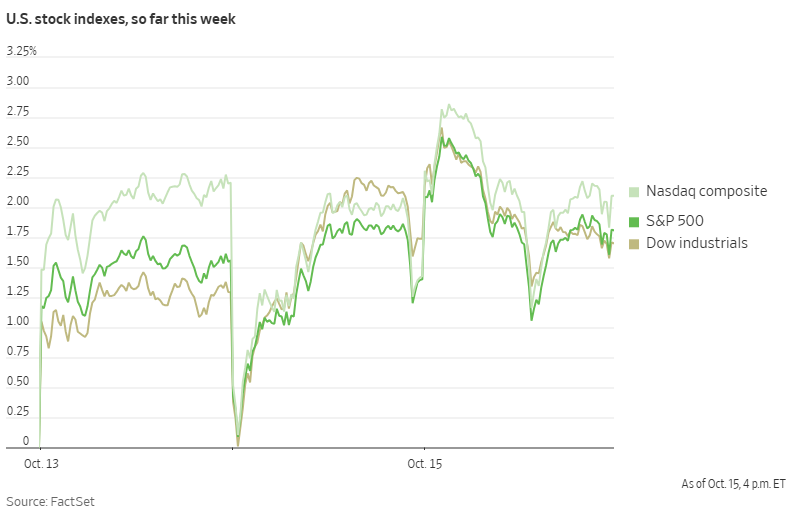
On the Australian front, the benchmark ASX 200 leapt 1.03% to 8990.99, with all four major Australian banks playing a major role. CBA closed 1.45% higher, Westpac 1.98%, NAB 1.87%, and ANZ 0.53%.
These strong bank results indicate broader economic strength, despite recent concerns about US-China trade tensions. US Treasury Secretary Scott Bessent emphasised that Washington did not want to escalate trade conflict with China and noted that President Trump is ready to meet Chinese President Xi Jinping in South Korea later this month.
With the third-quarter earnings season just getting underway, these early positive results from financial institutions could prove as the start of continued market strength through to the end of the year.
U.S. Government Shutdown Likely to Last Into November
Washington remains gridlocked as the U.S. enters its 16th day of shutdown. With no signs of compromise on the horizon, it appears increasingly likely the shutdown will extend into November and could even compromise the Thanksgiving holiday season.
Treasury Secretary Scott Bessent has warned "we are starting to cut into muscle here" and estimated "the shutdown may start costing the US economy up to $15 billion a day."
The core issue driving the shutdown is healthcare policy, specifically the expiring Affordable Care Act subsidies. Democrats are demanding these subsidies be extended, while Republicans argue this issue can be addressed separately from government funding.
The Trump administration has taken steps to blunt some of the shutdown's immediate impact, including reallocating funds to pay active-duty soldiers this week and infusing $300 million into food aid programs.
However, House Speaker Mike Johnson has emphasised these are merely "temporary fixes" that likely cannot be repeated at the end of October when the next round of military paychecks is scheduled.
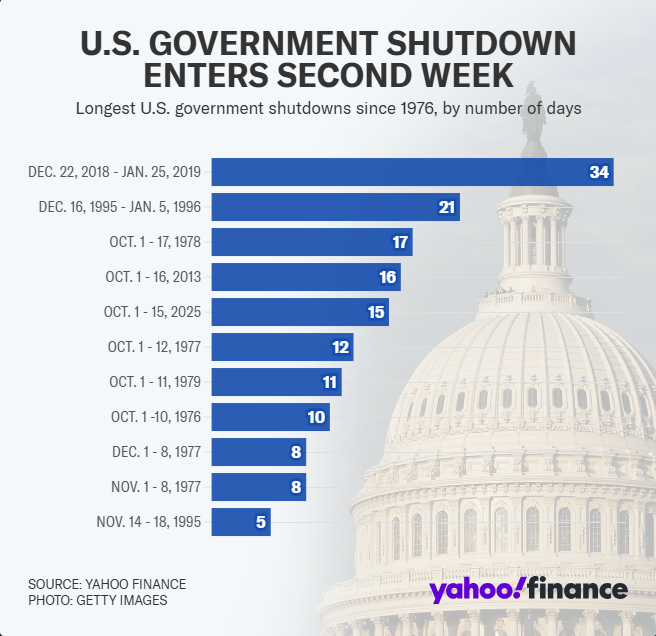
By the end of this week, this shutdown will become the third-longest in U.S. history. If it continues into November 4th, it will surpass the 34-day shutdown of 2018-2019 to become the longest government shutdown ever recorded.
This prolonged shutdown adds another layer of volatility to markets. While previous shutdowns have typically had limited long-term market impacts, the unprecedented length and timing of this closure, combined with its expanding economic toll, warrant closer attention as we move toward November.
Trump Announces Modi Has Agreed to Stop Buying Russian Oil
Yesterday, Trump announced that Indian Prime Minister Narendra Modi has agreed to stop purchasing Russian oil. He stated that Modi assured him India would halt Russian oil imports "within a short period of time," describing it as "a big step" in efforts to isolate Moscow economically.
The announcement comes after months of trade tensions between the US and India. In August, Trump imposed 50% tariffs on Indian exports to the US, doubling previous rates and specifically citing India's Russian oil purchases as a driving factor.

India has been one of Russia's top oil customers alongside China in recent years. Both countries have taken advantage of discounted Russian oil prices since the start of the Ukraine invasion.
Analysis suggests India saved between $2.5 billion to $12.6 billion since 2022 by purchasing discounted Russian crude compared to other sources, helping support its growing economy of 1.4 billion people.
Trump suggested that India's move would help accelerate the end of the Ukraine war, stating: "If India doesn't buy oil, it makes it much easier." He also mentioned his intention to convince China to follow suit: "Now I've got to get China to do the same thing."
The Indian embassy in Washington has not yet confirmed Modi's commitment. Markets will be closely watching for official statements from India and monitoring oil trading patterns in the coming weeks to assess the potential impact on global energy flows and prices.
Chart of the Day - Gold futures CFD (XAUUSD)


随着2025年5月的到来,全球金融市场再次迎来新的变数。澳大利亚降息预期升温,而美国的关税政策不断搅动全球贸易格局,给市场带来了不小的冲击。这两大经济体的政策动向正在重塑全球资本流向,投资者如何在这个复杂多变的环境中寻找机会,成为本月的主要关注点。澳洲经济与货币政策:降息预期主导市场情绪降息预期升温澳大利亚储备银行(RBA)将在5月20日召开货币政策会议,市场普遍预计RBA将启动新一轮降息周期,以应对经济增长放缓的压力。根据澳新银行(ANZ)的最新预测,RBA可能在5月、7月和8月连续三次降息,每次下调25个基点,使现金利率从目前的4.1%降至3.35%。更为激进的预测来自国民银行(NAB),该行甚至认为5月可能出现“双倍降息”(50个基点),并预计到2026年2月现金利率将降至2.6%。经济基本面支撑降息支持这一判断的经济数据也正在逐步显现。2025年一季度澳大利亚整体消费者价格指数(CPI)同比涨幅保持在2.4%不变,基础通胀率指标的截尾均值降至2.9%,均处于RBA设定的2%-3%目标区间内。这些数据为RBA在本月启动降息提供了充分的基本面支持。市场影响降息预期已经对澳洲资产价格产生显著影响。5月首周全澳房产拍卖清盘率跃升至70.1%,创近两年新高,其中墨尔本以74.4%领跑。同时,澳元汇率在工党连任后也呈现反弹态势,市场对政治稳定和货币政策转向的反应相对积极。然而,建筑业持续低迷,3月新建住宅批准量同比下滑8.8%,凸显高利率环境下行业的结构性困境。美国市场动态:关税政策引发全球连锁反应关税政策冲击波美国总统特朗普近期宣布计划对进口药品和海外制作的电影征收100%的关税,并对包括钢铝在内的其他商品征收25%的基础关税。这些措施延续了其一贯的贸易保护主义立场,导致全球供应链再次面临扰动风险。数据显示,美国商务部最新报告显示,2025年3月美国国际贸易逆差环比增长14%,达到创纪录的1405亿美元。这一数据反映了企业在关税政策实施前的囤货行为,同时也预示着未来贸易摩擦可能进一步加剧。市场反应与避险情绪受到关税政策影响,现货黄金价格一直持续上涨,屡次创下历史最高收盘价。然而,随着中国外交部宣布副总理将访问瑞士并与美国财长会晤的消息传出,金价从高位回落逾50美元,这表明市场对贸易紧张局势缓和的期待依然存在。另一方面,关税政策的不确定性导致美股近期波动加剧。苹果公司预计将在2025财年第三财季因美国关税政策损失约9亿美元,引发投资者对科技行业盈利前景的担忧,导致苹果股价单日下跌超3%。此外,道琼斯指数本周也出现下挫,能源与制造业板块表现尤其疲软。投资策略与市场展望利率敏感资产配置随着澳洲进入降息周期,利率敏感型资产如房地产投资信托(REITs)和高股息股票可能受益。历史数据显示,降息初期房地产板块通常表现优异,5月首周澳洲房产拍卖清盘率的大幅提升已印证这一趋势。投资者可关注质量优良的商业地产和住宅开发商股票。大宗商品对冲策略在全球贸易不确定性背景下,大宗商品作为通胀对冲工具的价值凸显。尽管近期黄金因贸易谈判消息短线回调,但长期来看,地缘政治风险和通胀压力仍可能支撑金价。能源板块也值得关注,特别是考虑到原油价格的近期反弹和澳洲本地能源股的强势表现。外汇市场机会澳元汇率波动为外汇交易者提供了机会。工党连任带来的政治稳定性、与中国贸易关系的改善以及即将到来的降息周期,这些因素共同作用可能导致澳元呈现区间震荡走势。交易者可关注0.6440-0.6500的关键技术区间,结合基本面消息灵活操作。 联系方式:墨尔本 03 8658 0603悉尼 02 9188 0418中国地区(中文) 400 120 8537中国地区(英文) +248 4 671 903作者:Yoyo Ma | GO Markets 墨尔本中文部


在瞬息万变的金融市场中,越来越多的投资者希望借助更智能、高效的方式来提升交易表现。对于没有时间全天盯盘、缺乏深入分析能力,或刚入门外汇和差价合约交易的新手来说,跟单交易(Copy Trading)无疑是一种便捷且具有吸引力的解决方案。cTrader Copy正是应运而生的创新功能,它集成于广受欢迎的cTrader交易平台中,专为希望复制他人策略或分享自己交易方法的用户设计。作为一个灵活且易于使用的投资平台,cTrader Copy提供了高度透明的策略信息、详尽的历史数据和明确的费用结构,帮助用户做出更明智的投资决策。无论你是希望低门槛跟随优秀交易者的个人投资者,还是寻求拓展影响力的策略提供者,cTrader Copy都能提供可靠的工具与支持。整个使用流程也非常简单:只需使用cTrader ID登录cTrader平台,进入复制区域,即可浏览大量可用策略,查看其历史表现与详细资料,比较费用与风险水平。选定策略后,仅需点击几次即可分配资金并开始复制交易,无需签署复杂合约或承担长期承诺。接下来的部分,我们将详细介绍如何一步步使用 cTrader Copy功能,从注册登录,到挑选适合自己的策略,再到正式开始跟单交易,助您轻松踏入智能投资的新阶段。首先,注册cTrader十分简便。我们GO Markets平台全面支持cTrader系统,已有账户的客户只需登录账户管理平台(Client Portal),即可额外申请一个cTrader交易账户。对于刚接触交易的新手,也可以选择先申请一个模拟账户进行练习。不过需要注意的是,模拟账户使用的是虚拟资金,您只能复制那些标记为免费的策略,无法体验付费策略的完整功能。打开我们的 cTrader 交易软件,在左侧菜单栏中点击“Copy”选项,即可进入策略列表主页。
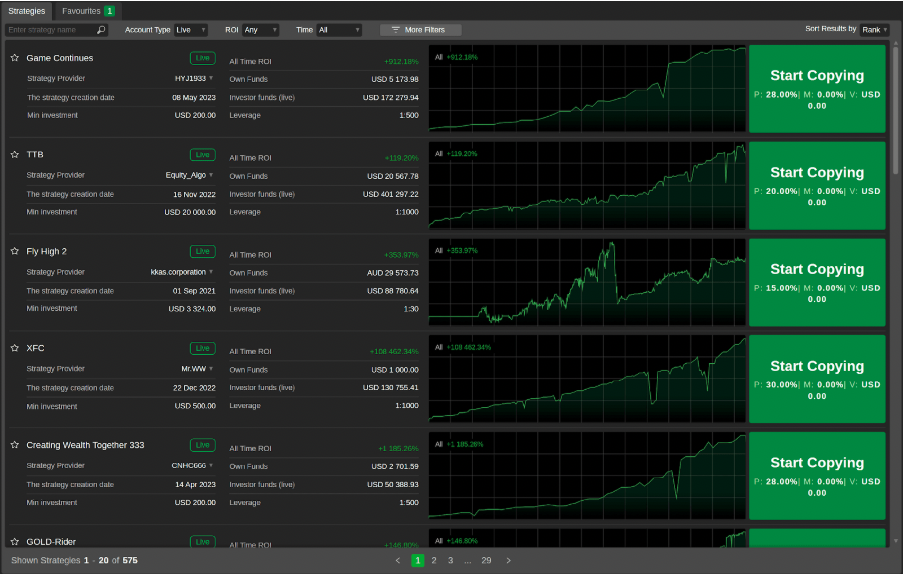
在“策略”选项卡中,您可以使用多种筛选器,根据个人偏好快速筛选出合适的策略。除了按策略名称进行搜索外,还可以根据账户类型、投资回报率(ROI)以及特定时间范围进行筛选。只需在下拉菜单中选择相应条件,系统便会自动更新并展示符合要求的策略列表。

点击策略列表中的任意策略,即可打开该策略的独立页面。每个策略页面都配有精选图表,方便您快速直观地查看和跟踪关键数据。向下滚动页面,您将看到一系列可视化图表,涵盖投资回报率、账户净值、历史业绩、交易量分布以及投资者相关统计数据。将光标悬停在图表上,即可查看更详细的数值与变化信息,帮助您全面评估策略表现。
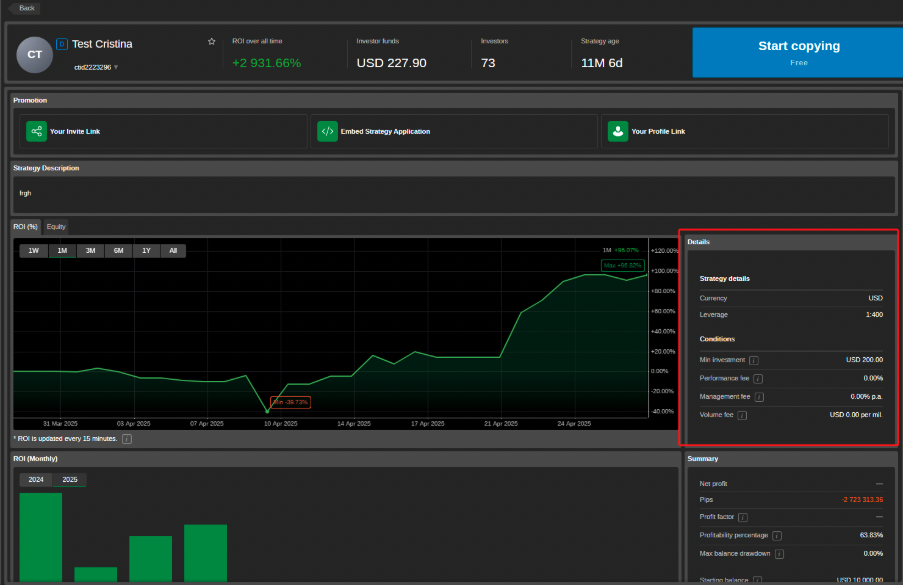
在详情(details)部分,您可以查看该策略的复制条件及费用信息,帮助全面评估投资成本与回报潜力。以下是一些关键参数的说明:最低投资额(Minimum Investment):指开始复制该策略所需的最低资金。如果在复制过程中账户净值低于该金额,将无法从复制账户中提取资金。绩效费(Performance Fee):基于高水位线(High Water Mark, HWM)模型,按策略为您带来的净利润收取的费用。管理费(Management Fee):策略提供者为管理投资者资金所收取的固定费用。交易量费用(Volume Fee):按交易量计费,投资者需为每复制一百万的交易量支付相应费用。了解这些费用结构后,投资者可以更有针对性地比较各个策略,选择最符合自身投资目标和成本预算的优质策略。
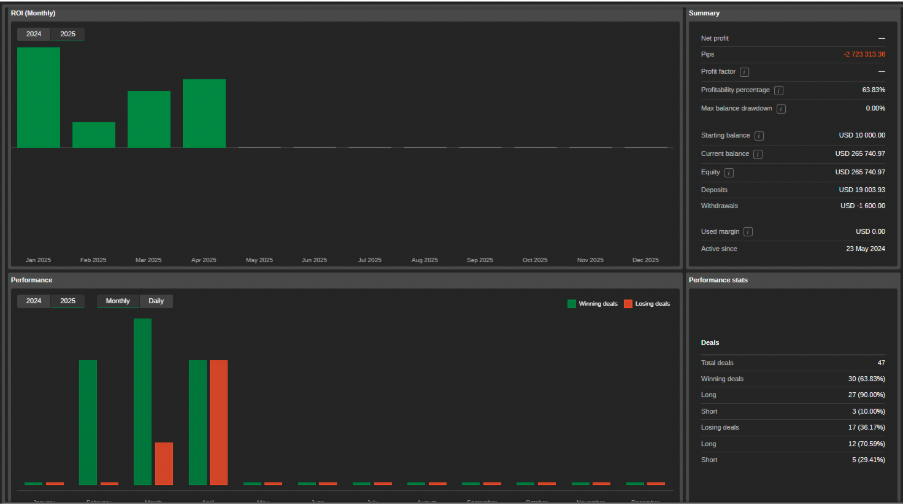
继续向下浏览页面,您将看到按月展示的盈亏和投资回报率(ROI)图表,便于直观了解策略在不同时间段的表现。图表右侧则列出了该策略的核心统计数据,包括净利润、累计点数、盈利因子、胜率、最大回撤、起始资金与当前余额等关键指标。此外,页面下方还提供了更详尽的交易数据分析。
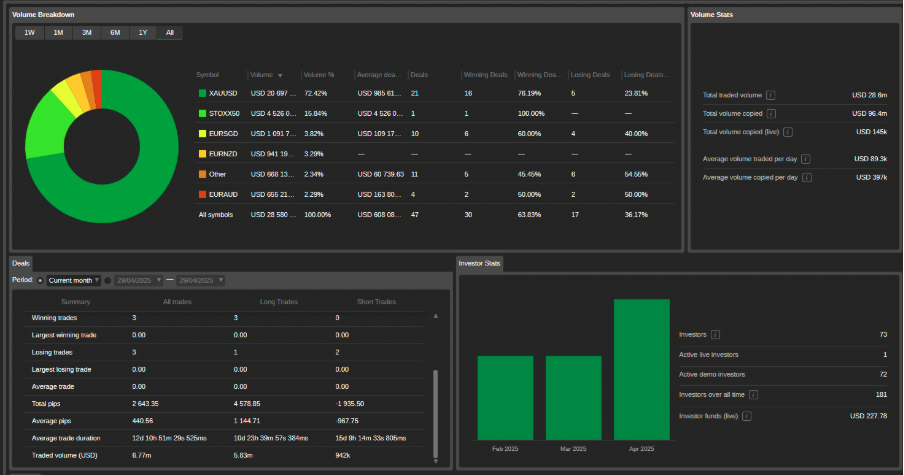
交易量明细饼图显示了交易的代码、各自的交易量、平均交易规模、每个代码的交易数量以及获胜和失败交易的数量及其在整个策略中占交易者总数的百分比。投资者统计图表则显示策略投资者相关的统计数据。
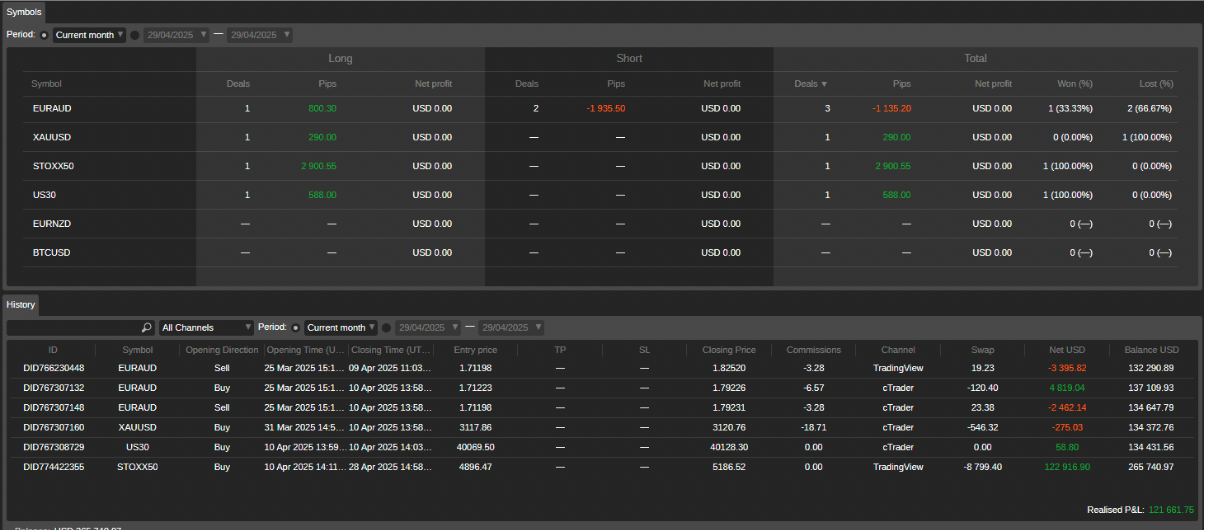
在交易品种(Symbol)选项卡中,系统会根据已平仓的交易情况,列出当前策略所涉及的所有交易品种。多头、空头以及总仓位的交易数量、点差、净利润和盈亏百分比等统计数据,均以对应列的形式清晰展示,便于对各品种表现进行细致分析。您还可以通过设置标准或自定义时间范围,对列表中的合约进行筛选,从而聚焦于特定时间段内的交易表现。在页面下方的历史记录(History)选项卡中,系统还完整列出了该策略的所有已平仓交易,帮助您进一步回顾策略的实际执行情况。通过以上介绍,您已经了解了如何使用 cTrader Copy功能来浏览、筛选并评估不同的复制策略。我们详细探讨了策略的关键数据指标,包括盈亏、投资回报率、交易品种的表现以及历史交易记录等。掌握这些信息后,您可以更加科学地选择最适合自己投资目标和风险偏好的策略。在选定合适的策略后,接下来的步骤是如何开始复制交易,并有效追踪后续的收益表现。在下一篇文章中,我们将深入讲解如何启动复制过程、资金分配、以及如何实时监控复制交易的收益与风险,帮助您更好地管理和优化投资组合。免责声明:GO Markets 分析师或外部发言人提供的信息基于其独立分析或个人经验。所表达的观点或交易风格仅代表其个人;并不代表 GO Markets 的观点或立场。联系方式:墨尔本 03 8658 0603悉尼 02 9188 0418中国地区(中文) 400 120 8537中国地区(英文) +248 4 671 903作者:Michael Miao | GO Markets 悉尼中文部


昨夜美股三大股指整体小幅回调,尽管跌幅有限,但在过去几周持续反弹后,这种整理被市场视为技术性回调的自然表现。目前市场情绪谨慎的主要来源,是有关新一轮关税政策的预期升温。相关消息显示,进口电影相关的关税仍在讨论中,具体实施细节尚未明确;医药领域的关税政策亦可能在近期发布更多内容;与此同时,日美之间的关税谈判未能达成协议,令市场对美国能否在90天内完成与多国关税谈判进程表示担忧。市场层面,伯克希尔·哈撒韦的高层调整对公司股价形成一定压力。德意志银行发表观点称,美国政策的不确定性可能成为美元长期走弱的风险因子,这与巴菲特在近期股东大会中的担忧不谋而合。高盛则认为,尽管近期经济数据有所放缓,但美联储并不会因此立即采取降息措施,尤其当前GDP的疲软主要被解释为进口激增的短期效应,通胀核心数据(PCE)回落也未显现出失控迹象。不过,值得注意的是,4月服务业数据显示服务活动加快,价格压力上升,后续通胀表现可能逐步受到关税政策影响,但考虑到油价仍被压制,整体通胀回升空间或仍有限。从板块表现看,纳指跌幅居前,主要受到科技板块承压影响。尽管AI板块多数下跌,但整体幅度不深,Meta、微软和谷歌小幅上涨稳定了指数,英伟达也仅小幅回落收盘。相较之下,苹果表现较弱,单日下跌超过3%,特斯拉和亚马逊亦有明显回调。

AI应用方面,PLTR盘后跌幅超过8%。尽管财报数据整体符合市场预期,包括营收、每股收益和全年业绩指引均达到机构预测,但市场对其战略商业合同收入下调有所反应,指引区间大幅低于去年同期,同时国际商业营收同比下降5%。因此股价出现较大调整。不过,从基本面看,此次财报并无重大利空,更多属于前期涨幅较大后短期的技术性调整,中期依然具备持有价值。核能相关板块方面,铀矿股整体回调,核技术类企业跌幅相对更深,但竞争性电力公司如VST和CEG则表现出色,逆市上涨,逐步收复前期因政策波动带来的下跌空间。AI板块的回调亦波及到量子计算概念,整体出现普跌。黄金股则因金价大幅反弹普遍走强,表现亮眼。预计今日澳股走势或延续昨日疲弱情绪,跟随隔夜美盘表现。在宏观市场层面,美元指数基本维持在99-100震荡区间内,走势符合预期。黄金则在昨日大幅上涨,延续此前分析所述:当前避险情绪升温,但美元未能有效走强,导致部分避险资金流向黄金,推升其价格。从高点3500回落至3200支撑后,金价技术性反弹也属正常,目前中期依然维持看涨判断,短期则受美元走势影响出现宽幅波动。
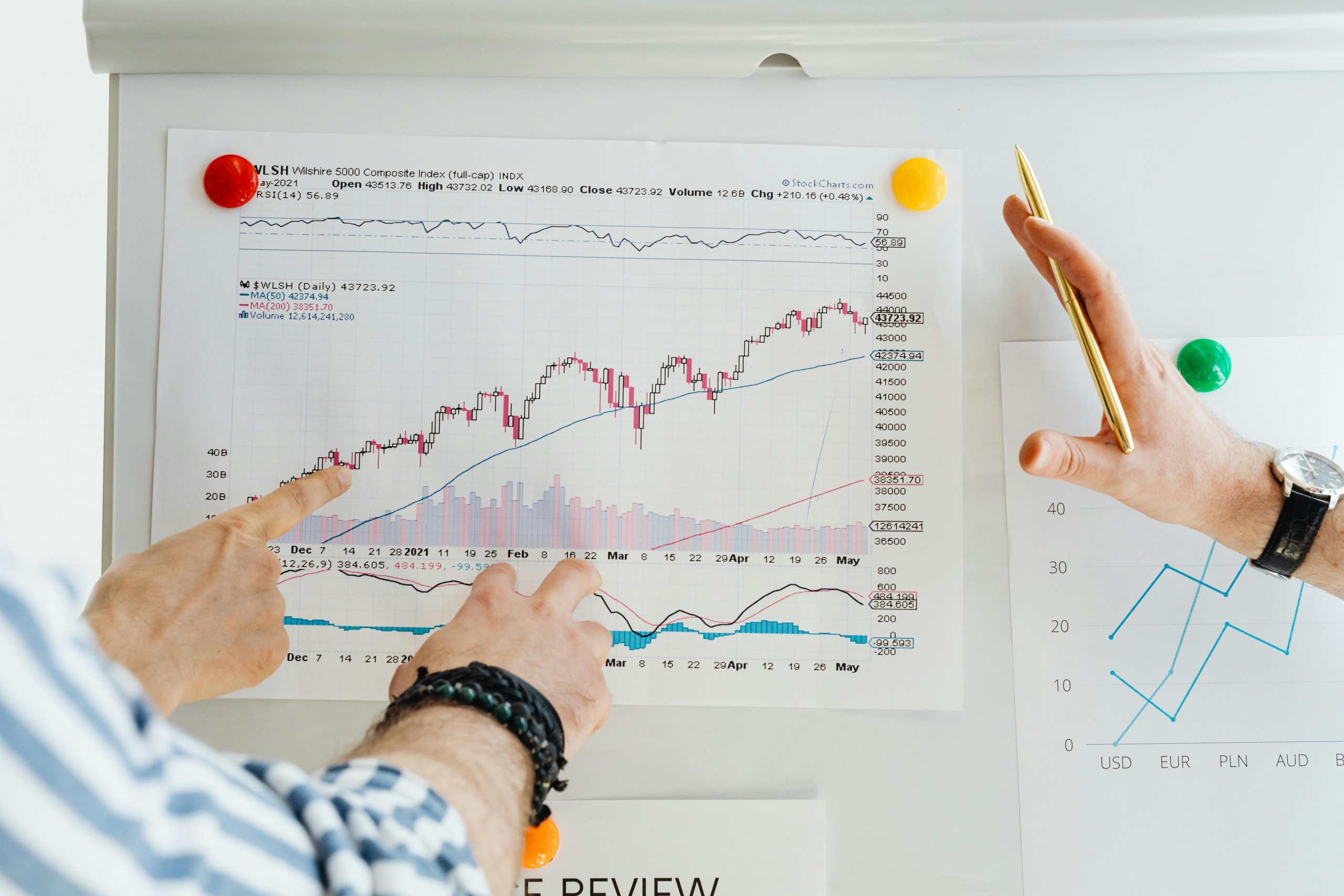
恐慌指数明显上升,但恐慌期货反弹幅度有限,显示整体市场情绪尚未失控,短期仍处于可控区间。油价则因地缘局势复杂化继续低迷运行,对短期全球通胀压力形成一定缓冲。比特币波动不大,亚盘今日或迎来阶段性上涨。此外,香港金管局继续采取措施释放流动性,通过卖出港元稳定汇率区间,同时提振股市表现。外汇方面,美元整体维持低位震荡,但跌幅不大,澳元兑美元持续站稳0.645一线,美日维持区间波动,美元兑人民币小幅回落至7.2平台。整体汇市延续稳中偏弱的美元格局。联系方式:墨尔本 03 8658 0603悉尼 02 9188 0418中国地区(中文) 400 120 8537中国地区(英文) +248 4 671 903作者:Xavier Zhang | GO Markets 墨尔本中文部


IntroductionMarcus stared at his computer in disbelief. The EUR/USD had just broken through what he'd convinced himself was a textbook “double bottom” formation. He has taken a larger position than his normal position, doubling his normal lot size on the back of a feeling of certainty that the pattern signalled a major reversal. Instead, the market moved downwards and then down some more. triggering his stop-loss and wiping out three weeks of gains.Despite the belief that the pattern was so clear, what he experienced was not unusual and will be a familiar story to many of us – it was simply his brain doing exactly what it has evolved to do, that is finding patterns, even when none existed (or even if they did there were ither reasons why an apparently textbook entry shouldn’t have been taken.In simple terms, our mind is naturally programmed to find patterns everywhere, it is how we have survived as a species and how we make sense of the sometimes-complex world around us. This has been the case ever since we have existed. Early hunters who quickly identified the subtle pattern of a predator moving within tall grass lived longer than those who dismissed such signals as random noiseWhen we look at trading charts, this same instinct kicks in, sometimes making us see meaningful patterns which, on more in-depth examination, could simply be random price movementsFields like behavioural finance and cognitive psychology have revolutionised our understanding of the interactions between financial markets and traders like you or me, demonstrating that traders often act in predictably irrational ways.Rather than being the perfectly rational participants in the market we would all like to always be, we are vulnerable to using numerous mental shortcuts and have so-called biases that can distort our perception of market action.At its foundation principles, behavioural finance recognises and explores why traders often make choices based on emotions, mental shortcuts, and social influences and explains why traders sometimes make decisions that go against their own best interests in the “heat” of the market action.This article aims to explore this concept in a little more detail and offer some practical suggestions as to how best to manage what may be at the basis of substantial risk to trading results.The Cognitive Science Behind Pattern RecognitionPattern recognition is our mind's ability to identify familiar structures or relationships in information. In trading, this means spotting formations in price charts (like "head and shoulders" or "double top" patterns as obvious examples) that we believe can predict future price movements.When analysing price movements across any tradable asset, when looking at price movements on a chart, on any timeframe, we automatically search for recognisable structures such as triangles, channels, support and resistance that might produce an expected move in a certain direction for a period subsequently.Some have suggested that this tendency relates to pareidolia, the same phenomenon that causes us to see faces in clouds or the famous "face on Mars." Our neural networks are primed to extract signal from noise, sometimes creating connections where none exist.So, in a trading context, so-called pareidolia might result in us seeing a "bullish pattern" in what's random market noise.Neuroscience research suggests that our brains use less energy when processing pattern information than when processing random data, so it is thought that this creates some sort of preference for pattern-based explanations, making us vulnerable to seeing market trends that may be questionable as indicatorsPattern Recognition and Cognitive BiasesA cognitive bias is simple terms, an error in thinking that may alter decisions and judgments, often at the point where we are about to act. These mental shortcuts help us process information quickly, but can commonly lead to serious mistakes in trading, where accuracy often matters more than speed.Many types of bias have been described, and many of you may have heard “Inner circle” \webinars in the past on this topic. The bottom-line result is invariably a move away from a written trading plan, and rarely does it result in favourable trading outcomes.For this article, let’s look at four common biases that are relevant to pattern recognition.
- Confirmation Bias
Confirmation bias is our tendency to more easily notice information that supports what we already believe, and inadvertently ignore information that may contradict our beliefs. In trading, this means paying attention to signals that confirm our market outlook while dismissing evidence that may suggest that perhaps what we are considering has a low probability of being successful.So, as an example, someone trading an oil futures CFD has an idea that the oil price could rally due to colder-than-expected weather conditions over the next few days. After entering a position, they might focus exclusively on weather reports predicting a continuation of cold levels, ignoring important data that suggested manufacturing activity (and so demand for energy) had come in lower than the market had expected. This “blindsiding” wasn’t because the information wasn't available, but because it had been filtered it out of the analysis relating to risks associated with taking such a position. This selective attention commonly happens undeliberately and requires a conscious effort to consider information, be it on a chart or news release, outside of what you are immediately focused on.
- Clustering Illusion
So-called “clustering illusion” happens when we mistake random events for meaningful patterns.In a trading context, this might be believing that certain days of the week consistently produce market movements in a particular direction, when a more rigorous investigation may suggest that the data doesn't support this conclusion.The clustering illusion involves perceiving meaningful patterns in genuinely random sequences. This bias manifests frequently in commodity and cryptocurrency markets, where volatility creates plenty of noise that can be mistaken for a technical signal that may be shaping up to be a change in sentiment.The danger with this is that even a handful of repeated similar price movements over a few trades may be convincing enough to suggest to the trader that he or she may be “onto something”.Commonly, when we are in this convinced state, we begin to take action regularly and have been so “duped” that this could be good and even excited about finding something potentially special, that it may take several losses, often heavy, before giving up on this as a trading idea.With further examination, it may have been identified that the previous "pattern" was merely coincidental clustering in an otherwise random sequence, obscured by our desire for pattern recognition and seeing some order in chaos.
- Narrative Fallacy
The narrative fallacy is our need to create stories that help us to explain why markets move the way they do. While these stories make us feel like we understand what's happening, they often oversimplify complex market dynamics and lead us astray.Humans look for stories that explain often complex phenomena, leading us to create narratives around what are fairly random or low probability price movements.Generally speaking, we may do this “plant our flag: thinking to explain what may be happening not only as it may feel satisfying but also because this often-misplaced understanding helps us to feel “in control” (and so in a better place to take action) rather than being at the mercy of frequent changes in sentiment.This preference for stories that make sense rather than more accurate ones based on more robust evidence can result in a succession of disappointing trade decisions.
- Recency Bias
Recency bias means giving too much importance to recent events when making decisions.In trading, there are a couple of ways that this is commonly demonstrated.Firstly, it often leads to chasing trends that have already peaked or have been underway for some time already, and we fear missing out on any further move in the same direction, only to see the price reverse soon after we enter.Another “symptom” can be that it may result in panicking after a few bad trades, even if your initial strategy has been robust, sound. The pattern of giving more back to the market may lead us to expect the same and exit a position too early when there is no actual technical evidence to do so.Recency bias can therefore often lead to late entry or early exit, both of which are likely to be detrimental to overall trading outcomes.The major solution is not only as with all cognitive biases to own that this is what you are doing, but, in this case, take a further look back on previous longer-term trading history, not just the last few trades, to help thatPractical Strategies to Manage Pattern BiasesFighting cognitive biases all starts with ownership of your trading behaviour. Too commonly, we look to place the blame for poorer results elsewhere, e.g. on markets, where the reason is internal within our distorted thinking at the point of taking trading action. requires creating systems that protect you from your thinking errors. Below are THREE practical approaches that any trader, regardless of experience level, can implement.
- Creating Trading Rules Before Seeing the Data
These are specific rules you write down BEFORE looking at today's market action. By deciding in advance what would make you buy or sell, you prevent your brain from "seeing" patterns that may not really be there.As well as specific, unambiguous written criteria in the form of a formal trading plan, we have talked before about the merits of a “daily agenda” where you re-align with a plan, look at key information resources relevant to the day, and standards of good trading practice. These will all help to put you in the optimum trading decision-making state and so less vulnerable to biases rearing their head during trading action.
- Maintaining a Trading Journal
A good trading journal records not just what trades you made, but why you made them and how you felt at the time. This helps you spot patterns in your behaviour that might be hurting your results.We have written before and presented examples of good practice on the potential effectiveness of journaling, including not just what was traded but why. This helps capture your trading mental state and pattern recognition process. Reviewing these notes regularly helps identify recurring psychological traps and, of course, is useful in the management of potential recency bias.
- Quantitative Validation Techniques
Moving onto a more advanced approach, this means using numbers and statistics, rather than gut feeling, to check if a pattern you think you see regularly really works.Moving beyond subjective chart interpretation, it is possible to develop more sophisticated ways to verify pattern validity.Even simple approaches can help such as tracking key metrics such as net profit, maximum drawdown, win rates and average gains/losses for specific patterns, across different strategies, trading direction and chosen markets vehicles can begin reveal which patterns are more likely to deserve your attention and of course those that should be ignored.Logically, if one accepts this, it may be worth creating code that allows some historical back-testing of your trading strategy ideas. This is possible even on the Metatrader platform strategy tester, even if your aim is not to go down an automated route in terms of confidence in the plan, it could be invaluable. Of course, increased confidence usually results in a decreased likelihood to stray from it and succumb to biases.In summaryOur pattern-seeking brains served us well not only in ancient times but do so in modern-day living, allowing us to function in a variety of complex situations. However, our inbuilt preference for seeing patterns when explored in the context of financial markets needs some awareness of potential risk and management.The line between skilled reading of sentiment and succumbing to potential cognitive bias can be very thin, with even experienced traders occasionally falling prey to false patterns that our mind convinces us may be there even if they are not.Through combining awareness of these psychological risks and putting the right things in place, traders can harness the strength of effective pattern recognition and timely action on a change in market sentiment, while minimising potential pitfalls.Your brain will naturally find patterns in market data – that is what brains do. Your responsibility as a trader is to recognise and manage this to be able to focus on what really works in your trading.
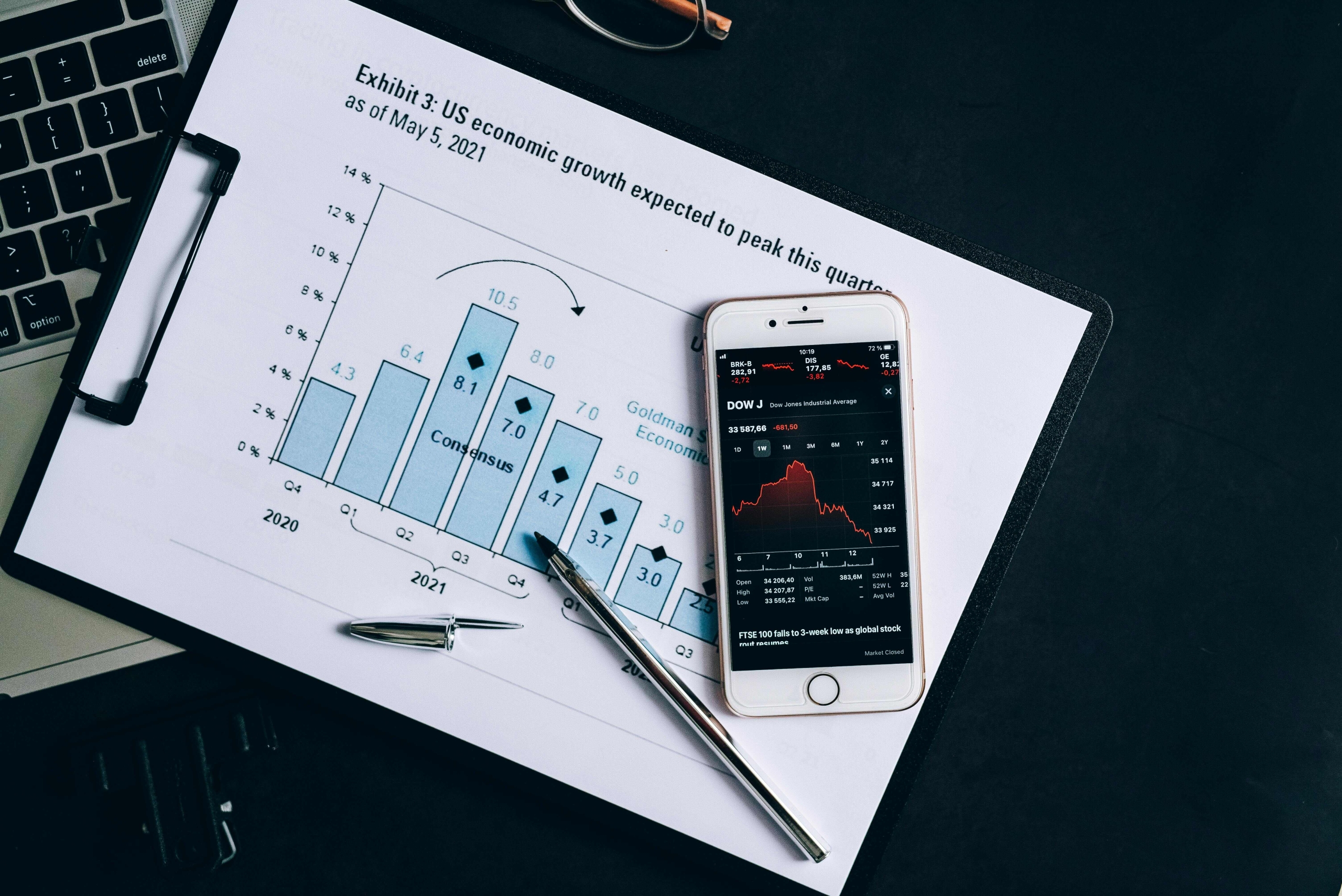

罕见GDP负增长2025年第一季度美国实际国内生产总值(GDP)按年率计算下降了0.3%,这是自2022年以来首次出现季度经济收缩。从GDP计算公式上看:GDP=消费+投资+政府支出+(出口-进口)下面是2025年第一季度美国GDP的影响因素:负面因素:
- 进口激增:企业和消费者在总统特朗普宣布新一轮关税政策之前,抢先大量进口商品,导致进口同比增长41.3%,创下历史新高。由于进口在GDP计算中被视为负项,这一激增对GDP造成了约4.8个百分点的拖累。
- 政府支出减少:下降了5.1%,对GDP增长构成了负面影响。
正面因素:
- 消费者支出:增长了1.8%,尽管受到冬季恶劣天气和节后消费疲软的影响,消费者支出仍增长了1.8%,对经济起到了一定的支撑作用。
- 企业投资:增长了21.9%,主要由于企业在关税实施前增加设备和库存投资。库存增加为GDP增长贡献了2.3个百分点。
- 出口小幅增长:出口增长了1.8%,但不足以抵消进口激增带来的负面影响。
是否陷入衰退?仍需观察GDP出现负增长并不等同于经济已陷入衰退。技术上通常需要连续两个季度负增长,或多个宏观指标出现全面恶化,才会被判断为“实质性衰退”。因此,除了GDP本身,还需持续关注以下几个核心指标:
- 非农就业与失业率:就业是经济最直接的健康信号。如果非农就业增长显著放缓,或失业率持续上升,意味着消费能力将受到冲击。
- 消费者支出与信心指数:如果消费连续几个月疲弱,且居民预期转差,将反映实际购买力下滑。
- 企业盈利和投资:企业若开始普遍裁员、削减资本支出,则将抑制未来增长动能。
- 债券收益率曲线:当前美债收益率曲线已倒挂,若持续时间延长,通常是未来经济收缩的领先指标。
- 实际收入变化:如果在通胀调整后,居民收入出现负增长,将直接限制消费增长空间。
- 制造业和工业生产:PMI与产出指数持续走弱,通常预示经济实体活动萎缩。
GDP下滑是警示,而非终局从成因来看,本次GDP下降主要由进口激增这一统计因素推动,具有一定的短期扰动性质;而非全面、系统性的需求崩盘。因此,它应被视作一次宏观预警信号,而非经济崩溃的实锤。不过,需要警觉的是,当前美国正面临多个结构性压力的叠加:高利率持续压制消费与信贷,政府财政空间受限,全球贸易格局趋于紧张,加之大选周期带来的政策不确定性,均可能在接下来几个季度中进一步冲击实体经济。结语:美利坚还撑得住吗?就当前情况而言,美国经济仍未陷入全面衰退。消费依然是稳定支撑,企业投资展现一定韧性,金融体系未见系统性风险。然而,GDP负增长已经是一记响亮的警钟,表明外部政策变动已对内需产生波动影响。是否“撑得住”,关键不在于一季度的表现,而在于未来两个季度:Q2是否继续负增长,消费与就业能否维持基本稳定,企业信心是否动摇。如果这些关键支柱发生实质性恶化,美国经济将面临真正意义上的衰退。而若后续数据企稳回升,则本次下滑有望被视为一次短暂扰动。联系方式:墨尔本 03 8658 0603悉尼 02 9188 0418中国地区(中文) 400 120 8537中国地区(英文) +248 4 671 903作者:Mill Li | GO Markets 墨尔本中文部


在金融市场中,信息的不对称往往决定了投资的成败。尽管 MT5 平台是一款功能强大的交易工具,能够满足绝大多数交易需求,但在关键的交易成本维度上,它却并不够直观友好——尤其是在保证金和盈亏的计算方面。当前投资者若想查看某一交易品种的保证金,只能在交易栏目中看到整体账户的保证金数额,并不能针对单一品种进行明确的展示。更麻烦的是,MT5 只有在订单成交之后,才会告诉你这笔交易实际占用了多少保证金。至于盈亏情况,平台同样缺乏预估工具,投资者无法在下单前模拟不同市场走势下的收益或损失情况。换句话说,你必须先下单,才知道这单到底“代价几何”。这不仅给投资者增加了操作难度,也埋下了潜在的风险隐患。俗话说得好:“凡事预则立,不预则废。”在交易这个对风险极度敏感的领域里,若不能在下单前清楚掌握成本与潜在回报,无异于闭着眼睛下注。幸运的是,我们还有另一种视角可以辅助决策。通过 Python 中的 MT5 模块,投资者可以用几行简单的代码,在下单之前就准确算出每一笔交易所需的保证金以及在不同点数变动下的盈亏情况。无需反复手动试单、也无需凭经验估算,让数据为你的风控提供坚实支持。接下来,我们来看看如何使用Python来计算保证金和盈亏。首先,与之前的步骤一样,我们需要连接到 GO Markets 的模拟账户。需要特别提醒的是:以下所有计算结果均基于模拟账户的参数设置,如杠杆比例、点值等。而在真实账户中,这些设置可能会有所不同,尤其是杠杆倍数,可能会对最终的保证金和盈亏数值产生显著影响。因此,实际操作时请以实盘账户的具体参数为准。
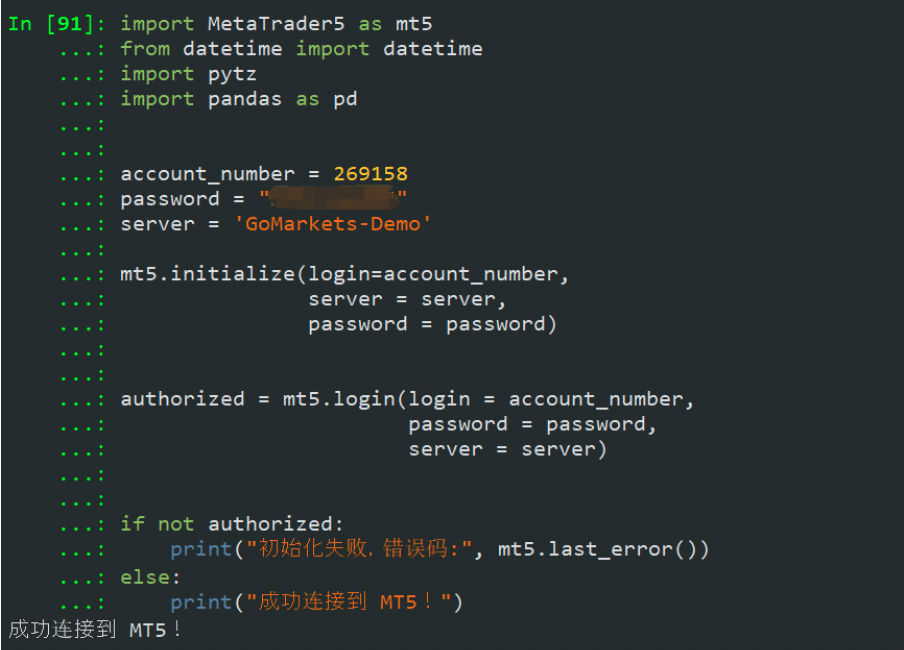
1. 如何使用Python计算保证金?在交易之前,了解一笔订单会占用多少保证金是极其重要的。幸运的是,借助Python中的MT5模块,我们可以通过一个函数order_calc_margin来实现这项计算。该函数可根据具体的交易参数,如交易品种、手数以及开仓价格,快速返回所需的保证金金额。该函数需要输入以下四个关键参数:action:交易方向,分为买入(ORDER_TYPE_BUY)和卖出(ORDER_TYPE_SELL)symbol:交易品种的代码,例如XAUUSD代表黄金volume:下单手数,例如 0.1price:开仓价格,通常可以使用当前的买入(ask)或卖出(bid)价格假设我们想要知道,开仓0.1手黄金多单(XAUUSD)时需要多少保证金,我们可以使用如下代码进行计算:
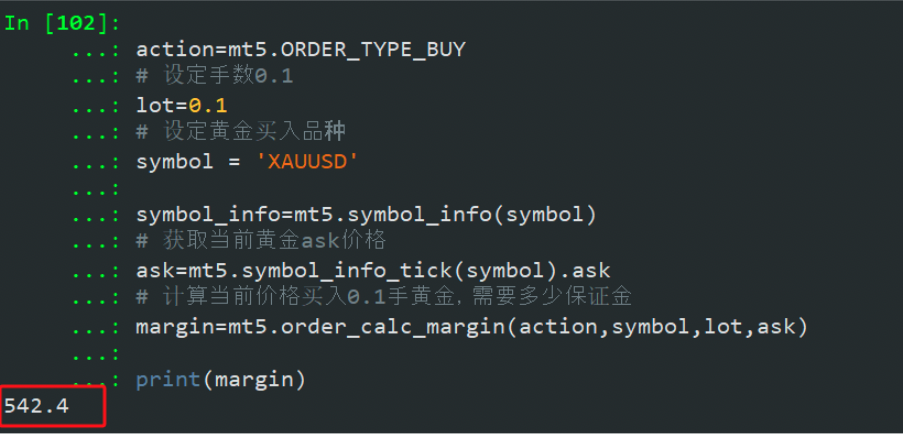
在运行程序后,假设当时黄金的买入价(ask price)为某个具体数值,系统返回的保证金金额为542.4澳元。这里需要注意一点:虽然黄金是以美元计价的交易品种,但该函数会根据当前汇率,自动将保证金金额换算为账户的基础货币——在本例中是澳元。为了验证计算的准确性,我们还可以在 MT5 平台上手动下单。下单成功后,在交易终端下方的“预付款”一项中,可以看到系统显示的保证金为542.24澳元,与 Python 程序计算出的结果几乎一致,误差可以忽略不计。这说明,通过Python计算出的保证金结果是可靠且精确的,投资者可以在下单前借助该方式进行预估,从而更好地控制仓位和风险。

2. 如何使用Python计算潜在盈亏?在交易中,风险控制无疑是最核心的一环。无论是短线操作还是中长期布局,我们都应该为每一笔交易设定清晰的风控计划,比如止盈、止损等策略。即便没有精确的点位,也应该具备一个大致的盈亏预期和心理底线。然而,制定风控计划的前提是:我们必须掌握足够的数据支持。尤其是在波动性较高的市场环境中,提前了解不同行情变化下的潜在盈亏情况,将直接影响我们的决策质量。举个例子——假设我们计划在当前价格买入1手黄金,那么如果市场随后出现下跌,在分别下跌1%、2%、3%、5%的情况下,我们的账户将会亏损多少?这类计算,就是风控规划中不可或缺的一步。为了提前评估交易风险,我们可以使用Python中的 order_calc_profit函数,对账户在不同市场表现下的盈亏进行模拟计算。该函数提供了一种简单、直观的方式,帮助投资者在下单前就了解市场波动可能带来的影响。order_calc_profit函数需要输入以下五个参数:action:交易方向,分为买入(ORDER_TYPE_BUY)和卖出(ORDER_TYPE_SELL)symbol:交易品种代码volume:交易手数price_open:开仓价格price_close:平仓价格通过设置不同的price_close值,我们可以模拟市场在出现1%、2%、3%、5%跌幅时,账户的浮动亏损情况。
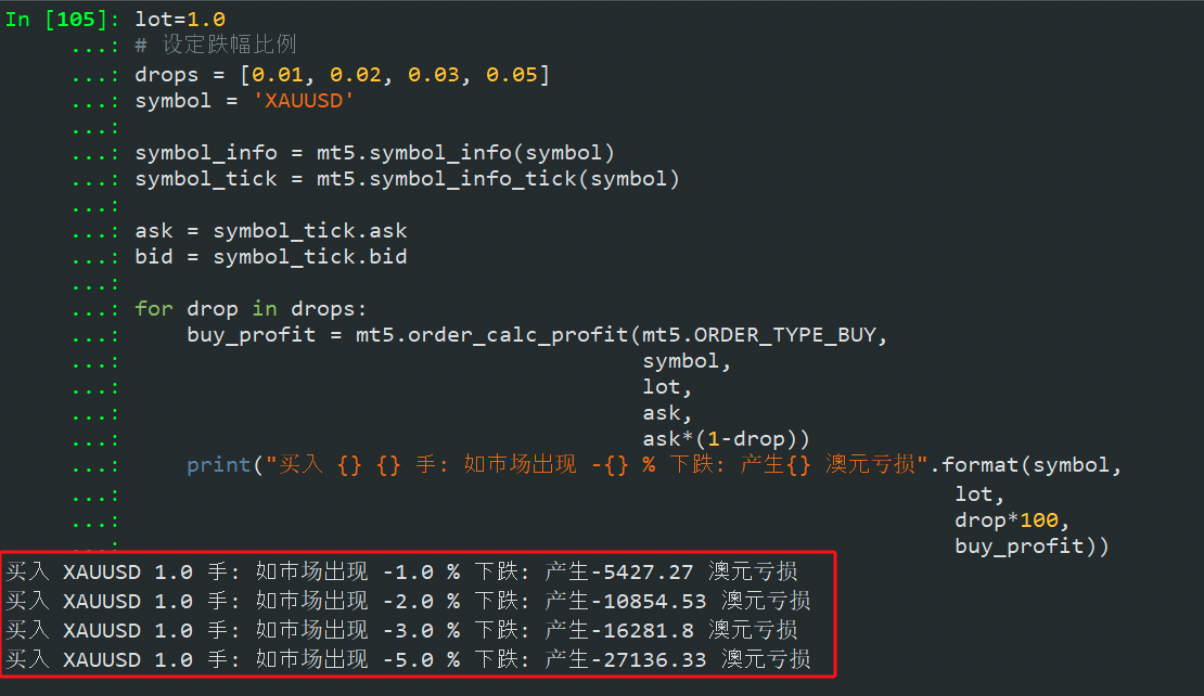
从结果中我们可以直观地看到,市场每下跌一个幅度,账户对应的亏损金额如何变化。这种可视化的分析方式,有助于我们在交易前更好地把控风险,做出更理性的决策。风控的关键在于预判,而不是事后补救。通过这样量化的方式,投资者能够更有底气、更有逻辑地应对市场的不确定性。通过本文的讲解,我们学习了如何使用 Python 调用 MT5 平台的接口,在交易前精准计算出每一笔订单的保证金和潜在盈亏。无论是评估仓位大小,还是制定止盈止损策略,这些数据都为投资者提供了切实可行的风险控制依据。在高风险、高波动的金融市场中,提前掌握交易成本与风险,不仅能够帮助我们避免盲目下单,更是迈向专业化交易的重要一步。当然,风控只是量化交易流程中的一部分。接下来的系列文章中,我们将进一步探索如何利用 Python 实现自动化下单、设置止盈止损、挂单交易等实用功能,帮助你搭建一个更智能、更高效的交易系统。如果你觉得本篇内容对你有所启发,欢迎点赞、收藏并持续关注后续更新。让我们一起用代码赋能交易,用数据守护本金!另附本文所有代码:import MetaTrader5 as mt5from datetime import datetimeimport pytzimport pandas as pdaccount_number = 269158password = "HzN!xoe4H#"server = 'GoMarkets-Demo'mt5.initialize(login=account_number,server = server,password = password)authorized = mt5.login(login = account_number,password = password,server = server)if not authorized:print("初始化失败,错误码:", mt5.last_error())else:print("成功连接到 MT5!")# 设定买入类型action=mt5.ORDER_TYPE_BUY# 设定手数0.1lot=0.1# 设定黄金买入品种symbol = 'XAUUSD'symbol_info=mt5.symbol_info(symbol)# 获取当前黄金ask价格ask=mt5.symbol_info_tick(symbol).ask# 计算当前价格买入0.1手黄金,需要多少保证金margin=mt5.order_calc_margin(action,symbol,lot,ask)print(margin)# 设定交易手数为1lot=1.0# 设定跌幅比例drops = [0.01, 0.02, 0.03, 0.05]symbol = 'XAUUSD'symbol_info = mt5.symbol_info(symbol)symbol_tick = mt5.symbol_info_tick(symbol)ask = symbol_tick.askbid = symbol_tick.bidfor drop in drops:buy_profit = mt5.order_calc_profit(mt5.ORDER_TYPE_BUY,symbol,lot,ask,ask*(1-drop))print("买入 {} {} 手: 如市场出现 -{} % 下跌: 产生{} 澳元亏损".format(symbol,lot,drop*100,buy_profit))联系方式:墨尔本 03 8658 0603悉尼 02 9188 0418中国地区(中文) 400 120 8537中国地区(英文) +248 4 671 903作者:Michael Miao | GO Markets 悉尼中文部

